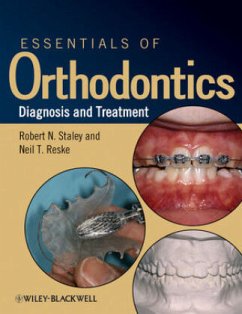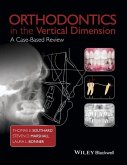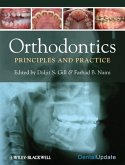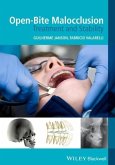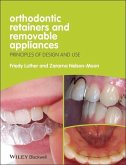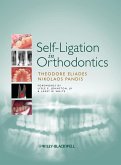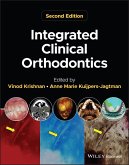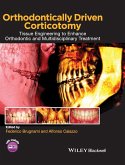- Broschiertes Buch
- Merkliste
- Auf die Merkliste
- Bewerten Bewerten
- Teilen
- Produkt teilen
- Produkterinnerung
- Produkterinnerung
Essentials of Orthodontics: Diagnosis and Treatment is designed to help dental students, orthodontic residents, and general dentists understand the basic concepts and procedures essential to the diagnosis, treatment planning, and treatment of patients who have relatively simple malocclusion problems.
The authors explain the steps of diagnosing basic orthodontic problems and analyzing dental radiographs and include many of the forms and charts dentists use for examination, diagnosis, and appliance design. Readers will learn about the mechanics of how appliances move teeth, the different…mehr
Andere Kunden interessierten sich auch für
![Orthodontics in the Vertical Dimension Orthodontics in the Vertical Dimension]() Thomas E. SouthardOrthodontics in the Vertical Dimension186,99 €
Thomas E. SouthardOrthodontics in the Vertical Dimension186,99 €![Orthodontics Orthodontics]() Daljit GillOrthodontics96,99 €
Daljit GillOrthodontics96,99 €![Open-Bite Malocclusion Open-Bite Malocclusion]() Open-Bite Malocclusion165,99 €
Open-Bite Malocclusion165,99 €![Orthodontic Retainers and Removable Appliances Orthodontic Retainers and Removable Appliances]() Friedy LutherOrthodontic Retainers and Removable Appliances87,99 €
Friedy LutherOrthodontic Retainers and Removable Appliances87,99 €![Self-Ligation in Orthodontics Self-Ligation in Orthodontics]() Theodore EliadesSelf-Ligation in Orthodontics187,99 €
Theodore EliadesSelf-Ligation in Orthodontics187,99 €![Integrated Clinical Orthodontics Integrated Clinical Orthodontics]() Integrated Clinical Orthodontics240,99 €
Integrated Clinical Orthodontics240,99 €![Orthodontically Driven Corticotomy Orthodontically Driven Corticotomy]() Orthodontically Driven Corticotomy143,99 €
Orthodontically Driven Corticotomy143,99 €-
-
-
Essentials of Orthodontics: Diagnosis and Treatment is designed to help dental students, orthodontic residents, and general dentists understand the basic concepts and procedures essential to the diagnosis, treatment planning, and treatment of patients who have relatively simple malocclusion problems.
The authors explain the steps of diagnosing basic orthodontic problems and analyzing dental radiographs and include many of the forms and charts dentists use for examination, diagnosis, and appliance design. Readers will learn about the mechanics of how appliances move teeth, the different types of appliances, and the orthodontic materials on the market. The authors also explain and demonstrate through color photos how to take dental impressions, create plaster casts, how to write a laboratory prescription for each appliance and how to create the various fixed and removable appliances. A needed text for the dental student, it is also an excellent resource for dentists wanting to expand their practice.
Key Features:
Practical manual for both diagnosing and developing treatment for simple malocclusions
Sample orthodontic forms
Examples show how to accurately write laboratory prescriptions for orthodontic devices
Step-by-step photos show appliances being created and used in treatment
Hinweis: Dieser Artikel kann nur an eine deutsche Lieferadresse ausgeliefert werden.
The authors explain the steps of diagnosing basic orthodontic problems and analyzing dental radiographs and include many of the forms and charts dentists use for examination, diagnosis, and appliance design. Readers will learn about the mechanics of how appliances move teeth, the different types of appliances, and the orthodontic materials on the market. The authors also explain and demonstrate through color photos how to take dental impressions, create plaster casts, how to write a laboratory prescription for each appliance and how to create the various fixed and removable appliances. A needed text for the dental student, it is also an excellent resource for dentists wanting to expand their practice.
Key Features:
Practical manual for both diagnosing and developing treatment for simple malocclusions
Sample orthodontic forms
Examples show how to accurately write laboratory prescriptions for orthodontic devices
Step-by-step photos show appliances being created and used in treatment
Hinweis: Dieser Artikel kann nur an eine deutsche Lieferadresse ausgeliefert werden.
Produktdetails
- Produktdetails
- Verlag: Wiley & Sons
- 1. Auflage
- Seitenzahl: 356
- Erscheinungstermin: 8. Februar 2011
- Englisch
- Abmessung: 245mm x 192mm x 21mm
- Gewicht: 857g
- ISBN-13: 9780813808680
- ISBN-10: 0813808685
- Artikelnr.: 32567768
- Herstellerkennzeichnung
- Libri GmbH
- Europaallee 1
- 36244 Bad Hersfeld
- gpsr@libri.de
- Verlag: Wiley & Sons
- 1. Auflage
- Seitenzahl: 356
- Erscheinungstermin: 8. Februar 2011
- Englisch
- Abmessung: 245mm x 192mm x 21mm
- Gewicht: 857g
- ISBN-13: 9780813808680
- ISBN-10: 0813808685
- Artikelnr.: 32567768
- Herstellerkennzeichnung
- Libri GmbH
- Europaallee 1
- 36244 Bad Hersfeld
- gpsr@libri.de
Robert N. Staley, D.D.S., M.A., M.S., is a professor in the Orthodontic Department at the University of Iowa College of Dentistry, where he has been on faculty since 1970. He is a diplomate of the American Board of Orthodontics, and among his many awards he received the Student Research Group Mentor of the Year Award for 2003-2004. Dr. Staley has served as an editorial consultant for various peer-reviewed journals and sits on the editorial board for The Angle Orthodontist. Neil T. Reske, M.A., also from the University of Iowa College of Dentistry, teaches dental students, orthodontic residents, and pediatric dentistry residents the principles and techniques of laboratory appliance fabrication.
Preface xiii
Acknowledgments xv
Introduction xvii
Chapter 1 Orthodontic Diagnosis and Treatment Planning 3
Normal and Ideal Occlusion 3
Normal Occlusion in the Primary Dentition 4
Centric Occlusion and Centric Relation 5
Angle Classification of Malocclusion 6
Angle Class I Malocclusion 6
Class I Malocclusions in the Primary and Mixed Dentitions 7
Angle Class II Division 1
Malocclusion 7
Angle Class II Division 2
Malocclusion 8
Class II Malocclusions in the Primary and Mixed Dentitions 8
End-to-End Occlusion 8
Angle Class III Malocclusion 9
Class III Malocclusions in Primary and Mixed Dentitions 9
Super Class I Malocclusions 9
Super Class II and Super Class III Malocclusions 9
Subdivision Malocclusions 9
Class II Subdivision Malocclusions 9
Class III Subdivision Malocclusions 9
Class II-III Subdivision Malocclusions 10
Incisor Dental Compensations in Class II and Class III Malocclusions 10
Iowa Notation System for Angle Classification 10
Rules for Assigning Angle Classification 10
Rating the Severity of a Malocclusion 11
Orthodontic Records 11
Clinical Examination 12
Summary of Findings, Problem List, and Diagnosis 16
Consultation with Patient and/or Parent 17
Chapter 2 Dental Impressions and Study Cast Trimming 19
Study Casts 19
Digital Casts 19
Alginate Impressions 20
Mandibular Impression 20
Maxillary Impression 21
Record of Centric Occlusion 21
Pouring of Plaster Study Casts 22
Study Cast Trimming 22
Chapter 3 Dental Cast Analysis in Adults 33
Tooth Size-Arch Length Analysis 33
Measurement of Tooth Size and Arch Length 33
Factors Influencing a Tooth Size-Arch Length Analysis 34
Curve of Spee 34
Incisor Inclination and Anteroposterior Position 36
Second and Third Molar Evaluation 36
Comparison of TSALD Analysis and the Irregularity Index 37
Arch Width Measurements 37
Diagnostic Setup 38
Bolton Analysis 38
Overbite and Overjet Measurements 40
Mandibular Crowding 42
Tooth Widths in Normal Occlusion 42
Chapter 4 Dental Cast Analysis in the Mixed Dentition 43
Tooth Size-Arch Length Analysis 43
Prediction of the Widths of Nonerupted Canines and Premolars 44
Radiographic Enlargement of Nonerupted Canines and Premolars 45
Revised Hixon-Oldfather Prediction Method 45
Iowa Prediction Method for Both Arches 48
Upper Arch 48
Lower Arch 48
Standard Error of Estimate 48
Radiograph Image Problems 53
Proportional Equation Prediction Method 53
Tanaka and Johnston Prediction Method 54
Measurement of Arch Lengths on Casts 54
Measurement Instruments and Guidelines 55
Factors that Influence a Mixed-Dentition Arch Length Analysis 55
Interpretation of a Mixed- Dentition Arch Length Analysis 55
Chapter 5 Radiographic Analysis 57
Periapical Survey 57
Panoramic Radiograph 57
Occlusal Radiographs 61
Cone Beam Radiographs 62
Lateral Cephalometric Radiographs 64
Anatomic Landmarks 65
Cephalometric Landmarks 65
Cephalometric Point Locations 66
Cephalometric Planes 67
Cephalometric Angles and Distances 68
Skeletal Angles and Distances 68
Dental Angles 69
Distances of Incisors to Anterior Vertical Lines 69
Cephalometric Norms and Treatment Goals 71
Lateral Cephalometric Tracing 71
Posteroanterior Cephalometric Radiograph 72
Analog versus Digital Radiography 73
Chapter 6 Lingual and Palatal Arches 75
Incisor Liability and Leeway Space 75
Passive Lower Lingual Holding Arch 75
Prevalence of Incisor Crowding 76
Premature Loss of a Primary Molar 77
Asymmetric Loss of a Primary Canine 78
Nance Holding Arch 79
Trans-palatal Arch 82
Insertion of a Passive Lingual or Palatal Arch 83
Fixed-Removable Lingual and Palatal Arches 84
Undesirable Side Effects of Passive and Active Lingual and Palatal Arches
86
Laboratory Prescription and Construction of a Lower Loop Lingual Arch 87
Failure of a Lower Lingual Arch 92
Chapter 7 Management of Anterior Crossbites 95
Prevalence of Anterior Crossbite Malocclusions 95
Angle Classification 96
Centric Relation to Centric Occlusion Functional Shift on Closure 96
Overbite 96
Adequate Arch Length 96
Inclination of Maxillary Incisor Roots 97
Rotation of Tooth in Crossbite 97
Number of Teeth in Crossbite 97
Alignment of Lower Anterior Teeth 97
Treatment of Anterior Crossbites with Removable Appliances 97
Treatment of Anterior Crossbites with Fixed Appliances 102
Construction of a Removable Maxillary Appliance to Close a Diastema and
Correct a Lateral Incisor in Crossbite 104
Chapter 8 Management of Posterior Crossbites 113
Definition of Posterior Crossbite 113
Prevalence of Posterior Crossbite Malocclusions 113
Angle Classification 114
Intermolar Width Measurements 114
Age of Patient 114
Buccolingual Inclination of the Posterior Teeth 114
Etiology of Bilateral and Unilateral Posterior Crossbites 115
Vertical Dimension 116
Treatment of Posterior Crossbites 116
Correction of Posterior Crossbites with Removable Appliances 116
Correction of Posterior Crossbites with Fixed Expander Appliances 123
Chapter 9 Management of Incisor Diastemas 135
Prevalence of Maxillary Diastemas 135
Etiologic Factors to Consider 135
Size of Teeth and Bolton Analysis 136
Arch Size 137
Maxillary Labial Frenum 137
Rotated Incisors 138
Thumb-Sucking Habit 138
Angle Classifi cation 139
Management with Appliances 139
Treatment of a Diastema with a Removable Loop Spring Appliance 139
Treatment of a Diastema with a Finger Spring Removable Appliance 141
Treatment of a Diastema Caused by a Thumb Habit 143
Treatment of a Diastema with the Edgewise Fixed Appliance 144
Chapter 10 Molar Uprighting and Space Regaining 151
Introduction 151
Ectopic Eruption of Permanent First Molars 151
Uprighting Molars in the Mixed Dentition 153
Ectopic Eruption of Upper First Molars 153
Ectopic Eruption and Tipping of Lower First Molars 158
Mesial Tipping of Permanent Molars after Loss of a First Molar 162
Prevention of Molar Tipping after Loss of a First Molar 164
Impaction of Second Molars 164
Loss of Both First and Second Molars 165
T-Loop Uprighting Spring and Edgewise Fixed Appliance 165
Forces Generated by the T-Loop Uprighting Spring 167
Patient Treated with a T-Loop Uprighting Spring 168
Helical Uprighting Spring 169
Forces Generated by the Helical Uprighting Spring 171
Patient Treated with a Helical Uprighting Spring 171
Other Appliances Used to Upright Molars 172
Repositioning of Teeth Prior to Prosthetic Restoration 172
Chapter 11 Orthodontic Examination and Decision Making for the Family
Dentist 177
Introduction 177
Orthodontic Screening 178
Guidelines for Orthodontic Decision Making 179
Problems 180
Pretreatment Records 180
Patient 1 181
Patient 2 182
Patient 3 184
Patient 4 186
Patient 5 187
Patient 6 189
Patient 7 190
Patient 8 192
Patient 9 193
Treatment Records 195
Patient 1 195
Patient 2 196
Patient 3 198
Patient 4 200
Patient 5 202
Patient 6 204
Patient 7 206
Patient 8 208
Patient 9 210
Chapter 12 How Orthodontic Appliances Move Teeth 213
Introduction 213
Biomechanics 216
Newton's First Law 218
Newton's Second Law 219
Keys to Understanding the Delivery of Orthodontic Forces 219
General Displacements of Rigid Bodies: Euler and Chasles 221
Limitations of Illustrating Three-Dimensional Tooth Movements in Two-
Dimensional Figures 221
Translation of a Tooth in the Edgewise Fixed Appliance 222
How a Tooth Is Translated in the Edgewise Fixed Appliance 222
Rotation of a Tooth in the Edgewise Fixed Appliance 225
Newton's Third Law 226
Chapter 13 The Edgewise Fixed Appliance 229
Introduction 229
The Edgewise Appliance 229
Arch Wires 230
Bands 231
Separators 231
Fitting a Band 231
Cementing a Band 231
Band Cements 232
Removal of Bands 232
Bonding of Brackets 232
Anatomic Considerations 233
The Straight Wire Appliance(TM) 234
Bracket and Molar Tube Placement 234
Direct and Indirect Bonding 236
Removal of Brackets and Bonded Attachments from Teeth 236
Arch Form 236
Chapter 14 Retention Appliances 239
Introduction 239
Fixed Retainers and Tooth Positioners 239
Invisible Retainers 243
Essix Retainers 249
Basic Retainer Design 251
Wire-Bending Skills 252
Maxillary Labial Bow Bending 254
Ball Clasp 267
C-Clasp 271
Adams Clasp 271
ReSta Clasp 285
Mandibular Labial Bow 294
Acrylicing Retainers 301
Acrylic Finishing and Polishing 307
Chapter 15 Orthodontic Materials 317
Introduction 317
Orthodontic Wires 317
Stainless Steel Wires 317
Sensitization 317
Cold Working 318
Recovery Heat Treatment 319
Annealing 319
Cobalt-Chromium-Nickel Wires 319
Beta-Titanium Wires 320
Nickel-Titanium Wires 320
Physical Properties of Orthodontic Wires 320
Wire Sizes 322
Electric Welding 323
Flame Soldering 324
Electric Soldering 324
Index 327
Acknowledgments xv
Introduction xvii
Chapter 1 Orthodontic Diagnosis and Treatment Planning 3
Normal and Ideal Occlusion 3
Normal Occlusion in the Primary Dentition 4
Centric Occlusion and Centric Relation 5
Angle Classification of Malocclusion 6
Angle Class I Malocclusion 6
Class I Malocclusions in the Primary and Mixed Dentitions 7
Angle Class II Division 1
Malocclusion 7
Angle Class II Division 2
Malocclusion 8
Class II Malocclusions in the Primary and Mixed Dentitions 8
End-to-End Occlusion 8
Angle Class III Malocclusion 9
Class III Malocclusions in Primary and Mixed Dentitions 9
Super Class I Malocclusions 9
Super Class II and Super Class III Malocclusions 9
Subdivision Malocclusions 9
Class II Subdivision Malocclusions 9
Class III Subdivision Malocclusions 9
Class II-III Subdivision Malocclusions 10
Incisor Dental Compensations in Class II and Class III Malocclusions 10
Iowa Notation System for Angle Classification 10
Rules for Assigning Angle Classification 10
Rating the Severity of a Malocclusion 11
Orthodontic Records 11
Clinical Examination 12
Summary of Findings, Problem List, and Diagnosis 16
Consultation with Patient and/or Parent 17
Chapter 2 Dental Impressions and Study Cast Trimming 19
Study Casts 19
Digital Casts 19
Alginate Impressions 20
Mandibular Impression 20
Maxillary Impression 21
Record of Centric Occlusion 21
Pouring of Plaster Study Casts 22
Study Cast Trimming 22
Chapter 3 Dental Cast Analysis in Adults 33
Tooth Size-Arch Length Analysis 33
Measurement of Tooth Size and Arch Length 33
Factors Influencing a Tooth Size-Arch Length Analysis 34
Curve of Spee 34
Incisor Inclination and Anteroposterior Position 36
Second and Third Molar Evaluation 36
Comparison of TSALD Analysis and the Irregularity Index 37
Arch Width Measurements 37
Diagnostic Setup 38
Bolton Analysis 38
Overbite and Overjet Measurements 40
Mandibular Crowding 42
Tooth Widths in Normal Occlusion 42
Chapter 4 Dental Cast Analysis in the Mixed Dentition 43
Tooth Size-Arch Length Analysis 43
Prediction of the Widths of Nonerupted Canines and Premolars 44
Radiographic Enlargement of Nonerupted Canines and Premolars 45
Revised Hixon-Oldfather Prediction Method 45
Iowa Prediction Method for Both Arches 48
Upper Arch 48
Lower Arch 48
Standard Error of Estimate 48
Radiograph Image Problems 53
Proportional Equation Prediction Method 53
Tanaka and Johnston Prediction Method 54
Measurement of Arch Lengths on Casts 54
Measurement Instruments and Guidelines 55
Factors that Influence a Mixed-Dentition Arch Length Analysis 55
Interpretation of a Mixed- Dentition Arch Length Analysis 55
Chapter 5 Radiographic Analysis 57
Periapical Survey 57
Panoramic Radiograph 57
Occlusal Radiographs 61
Cone Beam Radiographs 62
Lateral Cephalometric Radiographs 64
Anatomic Landmarks 65
Cephalometric Landmarks 65
Cephalometric Point Locations 66
Cephalometric Planes 67
Cephalometric Angles and Distances 68
Skeletal Angles and Distances 68
Dental Angles 69
Distances of Incisors to Anterior Vertical Lines 69
Cephalometric Norms and Treatment Goals 71
Lateral Cephalometric Tracing 71
Posteroanterior Cephalometric Radiograph 72
Analog versus Digital Radiography 73
Chapter 6 Lingual and Palatal Arches 75
Incisor Liability and Leeway Space 75
Passive Lower Lingual Holding Arch 75
Prevalence of Incisor Crowding 76
Premature Loss of a Primary Molar 77
Asymmetric Loss of a Primary Canine 78
Nance Holding Arch 79
Trans-palatal Arch 82
Insertion of a Passive Lingual or Palatal Arch 83
Fixed-Removable Lingual and Palatal Arches 84
Undesirable Side Effects of Passive and Active Lingual and Palatal Arches
86
Laboratory Prescription and Construction of a Lower Loop Lingual Arch 87
Failure of a Lower Lingual Arch 92
Chapter 7 Management of Anterior Crossbites 95
Prevalence of Anterior Crossbite Malocclusions 95
Angle Classification 96
Centric Relation to Centric Occlusion Functional Shift on Closure 96
Overbite 96
Adequate Arch Length 96
Inclination of Maxillary Incisor Roots 97
Rotation of Tooth in Crossbite 97
Number of Teeth in Crossbite 97
Alignment of Lower Anterior Teeth 97
Treatment of Anterior Crossbites with Removable Appliances 97
Treatment of Anterior Crossbites with Fixed Appliances 102
Construction of a Removable Maxillary Appliance to Close a Diastema and
Correct a Lateral Incisor in Crossbite 104
Chapter 8 Management of Posterior Crossbites 113
Definition of Posterior Crossbite 113
Prevalence of Posterior Crossbite Malocclusions 113
Angle Classification 114
Intermolar Width Measurements 114
Age of Patient 114
Buccolingual Inclination of the Posterior Teeth 114
Etiology of Bilateral and Unilateral Posterior Crossbites 115
Vertical Dimension 116
Treatment of Posterior Crossbites 116
Correction of Posterior Crossbites with Removable Appliances 116
Correction of Posterior Crossbites with Fixed Expander Appliances 123
Chapter 9 Management of Incisor Diastemas 135
Prevalence of Maxillary Diastemas 135
Etiologic Factors to Consider 135
Size of Teeth and Bolton Analysis 136
Arch Size 137
Maxillary Labial Frenum 137
Rotated Incisors 138
Thumb-Sucking Habit 138
Angle Classifi cation 139
Management with Appliances 139
Treatment of a Diastema with a Removable Loop Spring Appliance 139
Treatment of a Diastema with a Finger Spring Removable Appliance 141
Treatment of a Diastema Caused by a Thumb Habit 143
Treatment of a Diastema with the Edgewise Fixed Appliance 144
Chapter 10 Molar Uprighting and Space Regaining 151
Introduction 151
Ectopic Eruption of Permanent First Molars 151
Uprighting Molars in the Mixed Dentition 153
Ectopic Eruption of Upper First Molars 153
Ectopic Eruption and Tipping of Lower First Molars 158
Mesial Tipping of Permanent Molars after Loss of a First Molar 162
Prevention of Molar Tipping after Loss of a First Molar 164
Impaction of Second Molars 164
Loss of Both First and Second Molars 165
T-Loop Uprighting Spring and Edgewise Fixed Appliance 165
Forces Generated by the T-Loop Uprighting Spring 167
Patient Treated with a T-Loop Uprighting Spring 168
Helical Uprighting Spring 169
Forces Generated by the Helical Uprighting Spring 171
Patient Treated with a Helical Uprighting Spring 171
Other Appliances Used to Upright Molars 172
Repositioning of Teeth Prior to Prosthetic Restoration 172
Chapter 11 Orthodontic Examination and Decision Making for the Family
Dentist 177
Introduction 177
Orthodontic Screening 178
Guidelines for Orthodontic Decision Making 179
Problems 180
Pretreatment Records 180
Patient 1 181
Patient 2 182
Patient 3 184
Patient 4 186
Patient 5 187
Patient 6 189
Patient 7 190
Patient 8 192
Patient 9 193
Treatment Records 195
Patient 1 195
Patient 2 196
Patient 3 198
Patient 4 200
Patient 5 202
Patient 6 204
Patient 7 206
Patient 8 208
Patient 9 210
Chapter 12 How Orthodontic Appliances Move Teeth 213
Introduction 213
Biomechanics 216
Newton's First Law 218
Newton's Second Law 219
Keys to Understanding the Delivery of Orthodontic Forces 219
General Displacements of Rigid Bodies: Euler and Chasles 221
Limitations of Illustrating Three-Dimensional Tooth Movements in Two-
Dimensional Figures 221
Translation of a Tooth in the Edgewise Fixed Appliance 222
How a Tooth Is Translated in the Edgewise Fixed Appliance 222
Rotation of a Tooth in the Edgewise Fixed Appliance 225
Newton's Third Law 226
Chapter 13 The Edgewise Fixed Appliance 229
Introduction 229
The Edgewise Appliance 229
Arch Wires 230
Bands 231
Separators 231
Fitting a Band 231
Cementing a Band 231
Band Cements 232
Removal of Bands 232
Bonding of Brackets 232
Anatomic Considerations 233
The Straight Wire Appliance(TM) 234
Bracket and Molar Tube Placement 234
Direct and Indirect Bonding 236
Removal of Brackets and Bonded Attachments from Teeth 236
Arch Form 236
Chapter 14 Retention Appliances 239
Introduction 239
Fixed Retainers and Tooth Positioners 239
Invisible Retainers 243
Essix Retainers 249
Basic Retainer Design 251
Wire-Bending Skills 252
Maxillary Labial Bow Bending 254
Ball Clasp 267
C-Clasp 271
Adams Clasp 271
ReSta Clasp 285
Mandibular Labial Bow 294
Acrylicing Retainers 301
Acrylic Finishing and Polishing 307
Chapter 15 Orthodontic Materials 317
Introduction 317
Orthodontic Wires 317
Stainless Steel Wires 317
Sensitization 317
Cold Working 318
Recovery Heat Treatment 319
Annealing 319
Cobalt-Chromium-Nickel Wires 319
Beta-Titanium Wires 320
Nickel-Titanium Wires 320
Physical Properties of Orthodontic Wires 320
Wire Sizes 322
Electric Welding 323
Flame Soldering 324
Electric Soldering 324
Index 327
Preface xiii
Acknowledgments xv
Introduction xvii
Chapter 1 Orthodontic Diagnosis and Treatment Planning 3
Normal and Ideal Occlusion 3
Normal Occlusion in the Primary Dentition 4
Centric Occlusion and Centric Relation 5
Angle Classification of Malocclusion 6
Angle Class I Malocclusion 6
Class I Malocclusions in the Primary and Mixed Dentitions 7
Angle Class II Division 1
Malocclusion 7
Angle Class II Division 2
Malocclusion 8
Class II Malocclusions in the Primary and Mixed Dentitions 8
End-to-End Occlusion 8
Angle Class III Malocclusion 9
Class III Malocclusions in Primary and Mixed Dentitions 9
Super Class I Malocclusions 9
Super Class II and Super Class III Malocclusions 9
Subdivision Malocclusions 9
Class II Subdivision Malocclusions 9
Class III Subdivision Malocclusions 9
Class II-III Subdivision Malocclusions 10
Incisor Dental Compensations in Class II and Class III Malocclusions 10
Iowa Notation System for Angle Classification 10
Rules for Assigning Angle Classification 10
Rating the Severity of a Malocclusion 11
Orthodontic Records 11
Clinical Examination 12
Summary of Findings, Problem List, and Diagnosis 16
Consultation with Patient and/or Parent 17
Chapter 2 Dental Impressions and Study Cast Trimming 19
Study Casts 19
Digital Casts 19
Alginate Impressions 20
Mandibular Impression 20
Maxillary Impression 21
Record of Centric Occlusion 21
Pouring of Plaster Study Casts 22
Study Cast Trimming 22
Chapter 3 Dental Cast Analysis in Adults 33
Tooth Size-Arch Length Analysis 33
Measurement of Tooth Size and Arch Length 33
Factors Influencing a Tooth Size-Arch Length Analysis 34
Curve of Spee 34
Incisor Inclination and Anteroposterior Position 36
Second and Third Molar Evaluation 36
Comparison of TSALD Analysis and the Irregularity Index 37
Arch Width Measurements 37
Diagnostic Setup 38
Bolton Analysis 38
Overbite and Overjet Measurements 40
Mandibular Crowding 42
Tooth Widths in Normal Occlusion 42
Chapter 4 Dental Cast Analysis in the Mixed Dentition 43
Tooth Size-Arch Length Analysis 43
Prediction of the Widths of Nonerupted Canines and Premolars 44
Radiographic Enlargement of Nonerupted Canines and Premolars 45
Revised Hixon-Oldfather Prediction Method 45
Iowa Prediction Method for Both Arches 48
Upper Arch 48
Lower Arch 48
Standard Error of Estimate 48
Radiograph Image Problems 53
Proportional Equation Prediction Method 53
Tanaka and Johnston Prediction Method 54
Measurement of Arch Lengths on Casts 54
Measurement Instruments and Guidelines 55
Factors that Influence a Mixed-Dentition Arch Length Analysis 55
Interpretation of a Mixed- Dentition Arch Length Analysis 55
Chapter 5 Radiographic Analysis 57
Periapical Survey 57
Panoramic Radiograph 57
Occlusal Radiographs 61
Cone Beam Radiographs 62
Lateral Cephalometric Radiographs 64
Anatomic Landmarks 65
Cephalometric Landmarks 65
Cephalometric Point Locations 66
Cephalometric Planes 67
Cephalometric Angles and Distances 68
Skeletal Angles and Distances 68
Dental Angles 69
Distances of Incisors to Anterior Vertical Lines 69
Cephalometric Norms and Treatment Goals 71
Lateral Cephalometric Tracing 71
Posteroanterior Cephalometric Radiograph 72
Analog versus Digital Radiography 73
Chapter 6 Lingual and Palatal Arches 75
Incisor Liability and Leeway Space 75
Passive Lower Lingual Holding Arch 75
Prevalence of Incisor Crowding 76
Premature Loss of a Primary Molar 77
Asymmetric Loss of a Primary Canine 78
Nance Holding Arch 79
Trans-palatal Arch 82
Insertion of a Passive Lingual or Palatal Arch 83
Fixed-Removable Lingual and Palatal Arches 84
Undesirable Side Effects of Passive and Active Lingual and Palatal Arches
86
Laboratory Prescription and Construction of a Lower Loop Lingual Arch 87
Failure of a Lower Lingual Arch 92
Chapter 7 Management of Anterior Crossbites 95
Prevalence of Anterior Crossbite Malocclusions 95
Angle Classification 96
Centric Relation to Centric Occlusion Functional Shift on Closure 96
Overbite 96
Adequate Arch Length 96
Inclination of Maxillary Incisor Roots 97
Rotation of Tooth in Crossbite 97
Number of Teeth in Crossbite 97
Alignment of Lower Anterior Teeth 97
Treatment of Anterior Crossbites with Removable Appliances 97
Treatment of Anterior Crossbites with Fixed Appliances 102
Construction of a Removable Maxillary Appliance to Close a Diastema and
Correct a Lateral Incisor in Crossbite 104
Chapter 8 Management of Posterior Crossbites 113
Definition of Posterior Crossbite 113
Prevalence of Posterior Crossbite Malocclusions 113
Angle Classification 114
Intermolar Width Measurements 114
Age of Patient 114
Buccolingual Inclination of the Posterior Teeth 114
Etiology of Bilateral and Unilateral Posterior Crossbites 115
Vertical Dimension 116
Treatment of Posterior Crossbites 116
Correction of Posterior Crossbites with Removable Appliances 116
Correction of Posterior Crossbites with Fixed Expander Appliances 123
Chapter 9 Management of Incisor Diastemas 135
Prevalence of Maxillary Diastemas 135
Etiologic Factors to Consider 135
Size of Teeth and Bolton Analysis 136
Arch Size 137
Maxillary Labial Frenum 137
Rotated Incisors 138
Thumb-Sucking Habit 138
Angle Classifi cation 139
Management with Appliances 139
Treatment of a Diastema with a Removable Loop Spring Appliance 139
Treatment of a Diastema with a Finger Spring Removable Appliance 141
Treatment of a Diastema Caused by a Thumb Habit 143
Treatment of a Diastema with the Edgewise Fixed Appliance 144
Chapter 10 Molar Uprighting and Space Regaining 151
Introduction 151
Ectopic Eruption of Permanent First Molars 151
Uprighting Molars in the Mixed Dentition 153
Ectopic Eruption of Upper First Molars 153
Ectopic Eruption and Tipping of Lower First Molars 158
Mesial Tipping of Permanent Molars after Loss of a First Molar 162
Prevention of Molar Tipping after Loss of a First Molar 164
Impaction of Second Molars 164
Loss of Both First and Second Molars 165
T-Loop Uprighting Spring and Edgewise Fixed Appliance 165
Forces Generated by the T-Loop Uprighting Spring 167
Patient Treated with a T-Loop Uprighting Spring 168
Helical Uprighting Spring 169
Forces Generated by the Helical Uprighting Spring 171
Patient Treated with a Helical Uprighting Spring 171
Other Appliances Used to Upright Molars 172
Repositioning of Teeth Prior to Prosthetic Restoration 172
Chapter 11 Orthodontic Examination and Decision Making for the Family
Dentist 177
Introduction 177
Orthodontic Screening 178
Guidelines for Orthodontic Decision Making 179
Problems 180
Pretreatment Records 180
Patient 1 181
Patient 2 182
Patient 3 184
Patient 4 186
Patient 5 187
Patient 6 189
Patient 7 190
Patient 8 192
Patient 9 193
Treatment Records 195
Patient 1 195
Patient 2 196
Patient 3 198
Patient 4 200
Patient 5 202
Patient 6 204
Patient 7 206
Patient 8 208
Patient 9 210
Chapter 12 How Orthodontic Appliances Move Teeth 213
Introduction 213
Biomechanics 216
Newton's First Law 218
Newton's Second Law 219
Keys to Understanding the Delivery of Orthodontic Forces 219
General Displacements of Rigid Bodies: Euler and Chasles 221
Limitations of Illustrating Three-Dimensional Tooth Movements in Two-
Dimensional Figures 221
Translation of a Tooth in the Edgewise Fixed Appliance 222
How a Tooth Is Translated in the Edgewise Fixed Appliance 222
Rotation of a Tooth in the Edgewise Fixed Appliance 225
Newton's Third Law 226
Chapter 13 The Edgewise Fixed Appliance 229
Introduction 229
The Edgewise Appliance 229
Arch Wires 230
Bands 231
Separators 231
Fitting a Band 231
Cementing a Band 231
Band Cements 232
Removal of Bands 232
Bonding of Brackets 232
Anatomic Considerations 233
The Straight Wire Appliance(TM) 234
Bracket and Molar Tube Placement 234
Direct and Indirect Bonding 236
Removal of Brackets and Bonded Attachments from Teeth 236
Arch Form 236
Chapter 14 Retention Appliances 239
Introduction 239
Fixed Retainers and Tooth Positioners 239
Invisible Retainers 243
Essix Retainers 249
Basic Retainer Design 251
Wire-Bending Skills 252
Maxillary Labial Bow Bending 254
Ball Clasp 267
C-Clasp 271
Adams Clasp 271
ReSta Clasp 285
Mandibular Labial Bow 294
Acrylicing Retainers 301
Acrylic Finishing and Polishing 307
Chapter 15 Orthodontic Materials 317
Introduction 317
Orthodontic Wires 317
Stainless Steel Wires 317
Sensitization 317
Cold Working 318
Recovery Heat Treatment 319
Annealing 319
Cobalt-Chromium-Nickel Wires 319
Beta-Titanium Wires 320
Nickel-Titanium Wires 320
Physical Properties of Orthodontic Wires 320
Wire Sizes 322
Electric Welding 323
Flame Soldering 324
Electric Soldering 324
Index 327
Acknowledgments xv
Introduction xvii
Chapter 1 Orthodontic Diagnosis and Treatment Planning 3
Normal and Ideal Occlusion 3
Normal Occlusion in the Primary Dentition 4
Centric Occlusion and Centric Relation 5
Angle Classification of Malocclusion 6
Angle Class I Malocclusion 6
Class I Malocclusions in the Primary and Mixed Dentitions 7
Angle Class II Division 1
Malocclusion 7
Angle Class II Division 2
Malocclusion 8
Class II Malocclusions in the Primary and Mixed Dentitions 8
End-to-End Occlusion 8
Angle Class III Malocclusion 9
Class III Malocclusions in Primary and Mixed Dentitions 9
Super Class I Malocclusions 9
Super Class II and Super Class III Malocclusions 9
Subdivision Malocclusions 9
Class II Subdivision Malocclusions 9
Class III Subdivision Malocclusions 9
Class II-III Subdivision Malocclusions 10
Incisor Dental Compensations in Class II and Class III Malocclusions 10
Iowa Notation System for Angle Classification 10
Rules for Assigning Angle Classification 10
Rating the Severity of a Malocclusion 11
Orthodontic Records 11
Clinical Examination 12
Summary of Findings, Problem List, and Diagnosis 16
Consultation with Patient and/or Parent 17
Chapter 2 Dental Impressions and Study Cast Trimming 19
Study Casts 19
Digital Casts 19
Alginate Impressions 20
Mandibular Impression 20
Maxillary Impression 21
Record of Centric Occlusion 21
Pouring of Plaster Study Casts 22
Study Cast Trimming 22
Chapter 3 Dental Cast Analysis in Adults 33
Tooth Size-Arch Length Analysis 33
Measurement of Tooth Size and Arch Length 33
Factors Influencing a Tooth Size-Arch Length Analysis 34
Curve of Spee 34
Incisor Inclination and Anteroposterior Position 36
Second and Third Molar Evaluation 36
Comparison of TSALD Analysis and the Irregularity Index 37
Arch Width Measurements 37
Diagnostic Setup 38
Bolton Analysis 38
Overbite and Overjet Measurements 40
Mandibular Crowding 42
Tooth Widths in Normal Occlusion 42
Chapter 4 Dental Cast Analysis in the Mixed Dentition 43
Tooth Size-Arch Length Analysis 43
Prediction of the Widths of Nonerupted Canines and Premolars 44
Radiographic Enlargement of Nonerupted Canines and Premolars 45
Revised Hixon-Oldfather Prediction Method 45
Iowa Prediction Method for Both Arches 48
Upper Arch 48
Lower Arch 48
Standard Error of Estimate 48
Radiograph Image Problems 53
Proportional Equation Prediction Method 53
Tanaka and Johnston Prediction Method 54
Measurement of Arch Lengths on Casts 54
Measurement Instruments and Guidelines 55
Factors that Influence a Mixed-Dentition Arch Length Analysis 55
Interpretation of a Mixed- Dentition Arch Length Analysis 55
Chapter 5 Radiographic Analysis 57
Periapical Survey 57
Panoramic Radiograph 57
Occlusal Radiographs 61
Cone Beam Radiographs 62
Lateral Cephalometric Radiographs 64
Anatomic Landmarks 65
Cephalometric Landmarks 65
Cephalometric Point Locations 66
Cephalometric Planes 67
Cephalometric Angles and Distances 68
Skeletal Angles and Distances 68
Dental Angles 69
Distances of Incisors to Anterior Vertical Lines 69
Cephalometric Norms and Treatment Goals 71
Lateral Cephalometric Tracing 71
Posteroanterior Cephalometric Radiograph 72
Analog versus Digital Radiography 73
Chapter 6 Lingual and Palatal Arches 75
Incisor Liability and Leeway Space 75
Passive Lower Lingual Holding Arch 75
Prevalence of Incisor Crowding 76
Premature Loss of a Primary Molar 77
Asymmetric Loss of a Primary Canine 78
Nance Holding Arch 79
Trans-palatal Arch 82
Insertion of a Passive Lingual or Palatal Arch 83
Fixed-Removable Lingual and Palatal Arches 84
Undesirable Side Effects of Passive and Active Lingual and Palatal Arches
86
Laboratory Prescription and Construction of a Lower Loop Lingual Arch 87
Failure of a Lower Lingual Arch 92
Chapter 7 Management of Anterior Crossbites 95
Prevalence of Anterior Crossbite Malocclusions 95
Angle Classification 96
Centric Relation to Centric Occlusion Functional Shift on Closure 96
Overbite 96
Adequate Arch Length 96
Inclination of Maxillary Incisor Roots 97
Rotation of Tooth in Crossbite 97
Number of Teeth in Crossbite 97
Alignment of Lower Anterior Teeth 97
Treatment of Anterior Crossbites with Removable Appliances 97
Treatment of Anterior Crossbites with Fixed Appliances 102
Construction of a Removable Maxillary Appliance to Close a Diastema and
Correct a Lateral Incisor in Crossbite 104
Chapter 8 Management of Posterior Crossbites 113
Definition of Posterior Crossbite 113
Prevalence of Posterior Crossbite Malocclusions 113
Angle Classification 114
Intermolar Width Measurements 114
Age of Patient 114
Buccolingual Inclination of the Posterior Teeth 114
Etiology of Bilateral and Unilateral Posterior Crossbites 115
Vertical Dimension 116
Treatment of Posterior Crossbites 116
Correction of Posterior Crossbites with Removable Appliances 116
Correction of Posterior Crossbites with Fixed Expander Appliances 123
Chapter 9 Management of Incisor Diastemas 135
Prevalence of Maxillary Diastemas 135
Etiologic Factors to Consider 135
Size of Teeth and Bolton Analysis 136
Arch Size 137
Maxillary Labial Frenum 137
Rotated Incisors 138
Thumb-Sucking Habit 138
Angle Classifi cation 139
Management with Appliances 139
Treatment of a Diastema with a Removable Loop Spring Appliance 139
Treatment of a Diastema with a Finger Spring Removable Appliance 141
Treatment of a Diastema Caused by a Thumb Habit 143
Treatment of a Diastema with the Edgewise Fixed Appliance 144
Chapter 10 Molar Uprighting and Space Regaining 151
Introduction 151
Ectopic Eruption of Permanent First Molars 151
Uprighting Molars in the Mixed Dentition 153
Ectopic Eruption of Upper First Molars 153
Ectopic Eruption and Tipping of Lower First Molars 158
Mesial Tipping of Permanent Molars after Loss of a First Molar 162
Prevention of Molar Tipping after Loss of a First Molar 164
Impaction of Second Molars 164
Loss of Both First and Second Molars 165
T-Loop Uprighting Spring and Edgewise Fixed Appliance 165
Forces Generated by the T-Loop Uprighting Spring 167
Patient Treated with a T-Loop Uprighting Spring 168
Helical Uprighting Spring 169
Forces Generated by the Helical Uprighting Spring 171
Patient Treated with a Helical Uprighting Spring 171
Other Appliances Used to Upright Molars 172
Repositioning of Teeth Prior to Prosthetic Restoration 172
Chapter 11 Orthodontic Examination and Decision Making for the Family
Dentist 177
Introduction 177
Orthodontic Screening 178
Guidelines for Orthodontic Decision Making 179
Problems 180
Pretreatment Records 180
Patient 1 181
Patient 2 182
Patient 3 184
Patient 4 186
Patient 5 187
Patient 6 189
Patient 7 190
Patient 8 192
Patient 9 193
Treatment Records 195
Patient 1 195
Patient 2 196
Patient 3 198
Patient 4 200
Patient 5 202
Patient 6 204
Patient 7 206
Patient 8 208
Patient 9 210
Chapter 12 How Orthodontic Appliances Move Teeth 213
Introduction 213
Biomechanics 216
Newton's First Law 218
Newton's Second Law 219
Keys to Understanding the Delivery of Orthodontic Forces 219
General Displacements of Rigid Bodies: Euler and Chasles 221
Limitations of Illustrating Three-Dimensional Tooth Movements in Two-
Dimensional Figures 221
Translation of a Tooth in the Edgewise Fixed Appliance 222
How a Tooth Is Translated in the Edgewise Fixed Appliance 222
Rotation of a Tooth in the Edgewise Fixed Appliance 225
Newton's Third Law 226
Chapter 13 The Edgewise Fixed Appliance 229
Introduction 229
The Edgewise Appliance 229
Arch Wires 230
Bands 231
Separators 231
Fitting a Band 231
Cementing a Band 231
Band Cements 232
Removal of Bands 232
Bonding of Brackets 232
Anatomic Considerations 233
The Straight Wire Appliance(TM) 234
Bracket and Molar Tube Placement 234
Direct and Indirect Bonding 236
Removal of Brackets and Bonded Attachments from Teeth 236
Arch Form 236
Chapter 14 Retention Appliances 239
Introduction 239
Fixed Retainers and Tooth Positioners 239
Invisible Retainers 243
Essix Retainers 249
Basic Retainer Design 251
Wire-Bending Skills 252
Maxillary Labial Bow Bending 254
Ball Clasp 267
C-Clasp 271
Adams Clasp 271
ReSta Clasp 285
Mandibular Labial Bow 294
Acrylicing Retainers 301
Acrylic Finishing and Polishing 307
Chapter 15 Orthodontic Materials 317
Introduction 317
Orthodontic Wires 317
Stainless Steel Wires 317
Sensitization 317
Cold Working 318
Recovery Heat Treatment 319
Annealing 319
Cobalt-Chromium-Nickel Wires 319
Beta-Titanium Wires 320
Nickel-Titanium Wires 320
Physical Properties of Orthodontic Wires 320
Wire Sizes 322
Electric Welding 323
Flame Soldering 324
Electric Soldering 324
Index 327

